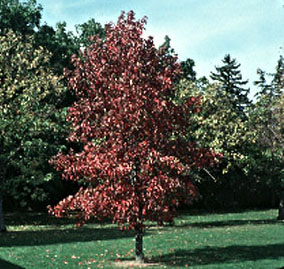

Sweetgum, (American sweetgum, or redgum), Liquidambar styraciflua, is an important southern hardwood and the only New World native among the 4 species belonging to the genus Liquidambar. It is a very desirable ornamental tree in milder northern areas due to its attractive shape, corky outgrowths on the twigs and branches, interesting spiny fruit clusters, and brilliant autumn colors of yellow, purple and red. It's hardy to central New York and can survive even in heavy, dry, clay soils. Another desirable attribute is that sweetgum has very few insect and disease problems. L. styraciflua is considered one of the best street trees in southern California. One of sweetgum's interesting botanical characteristics is its bright green, star-shaped leaves, which are deeply 57 lobed with serrate margins.

Both leaves and stems are fragrant when crushed, thus it's common name, sweetgum. Sweetgum's golden, pleasant-smelling sap also is responsible for it's genus name of Liquidambar. The sap is used to scent gloves in France. The sweet, resinous sap was also used to make gum, which was used both medicinally and as chewing gum. As such, the gum was chewed to ease sore throats, coughs and colds. The gum was also used during World Wars I and II to produce soaps, drugs and adhesives. Ointments made from sweetgum were used on wounds, cuts and skin disorders. The inner bark was often boiled in milk to cure diarrhea. In the southern states, twigs were dipped in whiskey and chewed for the same purpose. Oriental sweetgum, L. orientalis, also produces a sweetly scented resin known as storax, which is used commercially in the production of perfumes, soaps, and medicines as well as flavoring for candy, soft drinks and chewing gum.
Another attractive landscape feature is the curious corky ridges of young twigs and branches. Sweetgum fruits are spiny, resinous, woody balls made up of clusters of 2-seeded capsules that add an interesting texture to the tree as an ornamental in your landscape.
Leave plenty of room for your sweetgum to grow because, under ideal conditions, it is a moderate to rapidly growing tree that can reach 80 to 120 ft in height and 3 to 4 ft in diameter. L. styraciflua has a long, straight, buttressed trunk, oblong to pyramidal crown, and a shallow and wide spreading root system. Sweetgum reaches maturity at 200300 years, but begins to flower and fruit when 2025 years old. An aggressive pioneer of disturbed sites, sweetgum has abundant, viable seed production and little in the way of seed bed requirements. Stumps sprout prolifically, giving rise to multiple-stem clumps and stands. When stems are killed, weakened or top-cut, numerous root suckers often develop. Many sweetgum stands today are of sprout origin. Sweetgum is the most widespread and commercially important southeastern hardwood, able to grow on a wide variety of sites, but grows best on wet, rich alluvial soils. Liquidambar is one of the 3 principle timber-contributing genera of the witch-hazel family; and L. styraciflua is one of the more commercially important US hardwood species. Its wood is used primarily in the production of utility and decorative grade plywood panels and veneer. It was commonly used in the production of barrels and boxes. L. styraciflua is grown extensively for the southern paper industry in managed plantations. Because the unseasoned wood is very heavy (37 lb./cubic foot!) the trees are often girdled and left standing a year or more before being harvested.
Hamamelidaceae, or the witch-hazel family, has 23 genera, and 100 species of trees and shrubs distributed throughout forested areas of eastern North America, Mexico, Central America, South Africa, Madagascar, Australia, Asia, and Malayan Archipelago. This Arbor Day, consider Sweetgum as an excellent addition to your landscape!
by Cathy Heidenreich
Next (Sycamore)
Return to Arboretum Home Page
Return to NYS Agricultural Experiment Station Home Page